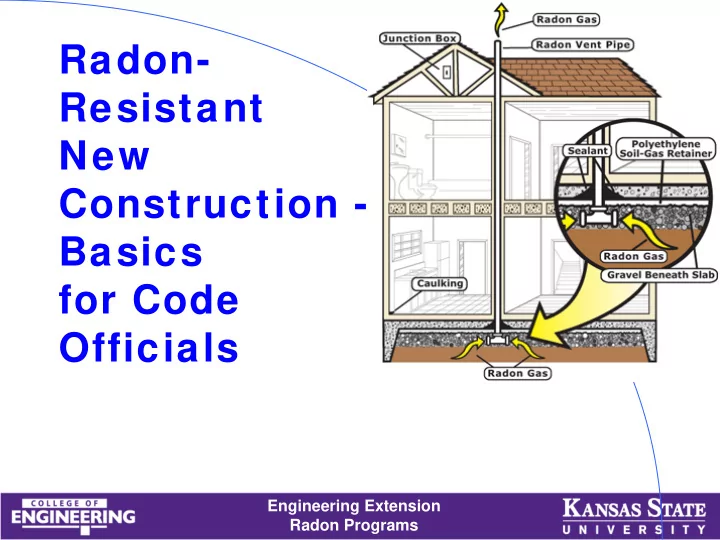

Radon- Resistant New Construction - Basics for Code Officials Engineering Extension Radon Programs
Radon Exposure in Homes Average annual radiation source Is Significant exposures for US citizens • Radon 222 - Naturally 2006 Occurring Radioactive Gas Element Radon Not Detected by o 37% Human Senses All Medical 48% Indoor o concentrations are created by the w ay w e design, build, and operate buildings w here w e live, learn, and w ork Engineering Extension Radon Programs
Basic Facts • Radon is Everyw here! • The only w ay to know the radon level is to test – it can’t be predicted • Your house may be low , your neighbor’s may be high • 95-99 out of 100 high homes can be fixed w ith fan pow ered soil suction systems • 2 nd leading cause of Lung Cancer! Engineering Extension Radon Programs
How Radon Enters Your Home How Radon Enters Your Home Engineering Extension Radon Programs
What Does It Take to Build the House Radon Resistant? • Foundation gas collection system • Pipe to convey gas through roof • A closed barrier betw een soil gas and indoor air • Provision to add fan if needed Engineering Extension Radon Programs
How Is the System Supposed to Work? • It is designed to vent radon from beneath the structure by use of a vent pipe routed through the conditioned space of a building, connecting the sub-slab area w ith outdoor air. • When air in the pipe is more buoyant that outside air, the air escaping the 70 pipe creates a slight degrees vacuum (pressure differential) to pull soil gas tow ards the outside • Know n as Passive Soil Depressurization - PSD Engineering Extension 55 degrees Radon Programs
Tw o Major Reasons Passive Soil Depressurization is Used 1. To reduce indoor radon concentrations • In general, about 50% reduction over the course of a year is expected if properly installed 2. To make the house easy to fix if further radon reduction is needed • By activation w ith a fan • Stack must easily accessible outside conditioned space for fan installation • Pow er must be available near fan • Major openings betw een soil and occupied space must be sealed 7 Engineering Extension Radon Programs
International Residential Code (IRC) Appendix F: RRNC (Initially intended for Zone 1) • Adoption is Adoption is • encouraged for all encouraged for all 1993 EPA Radon Zone Map zones as risk has zones as risk has increased since increased since 1993 1993 • EPA Radon Zones EPA Radon Zones • • Red = High potential Red = High potential • Zone 1 > 4.0 ave. Zone 1 > 4.0 ave. • Orange = Medium Orange = Medium • potential potential Zone 2, 2.0 to 4.0 Zone 2, 2.0 to 4.0 ave. ave. • Yellow = Low Yellow = Low • potential potential Zone 3 < 2.0 ave. Zone 3 < 2.0 ave. 8 Engineering Extension Radon Programs
IRC Appendix F: Section 103 IRC Appendix F: Section 103 Requirements (Overview ) Requirements (Overview ) 1. General 7. Vent Pipe 2. Subfloor Preparation Drainage 3. Soil-Gas Retarder 8. Vent Pipe Access 4. Entry Routes 9. Vent Pipe 5. Passive Identification Submembrane 10. Combination Depressurization Foundations (PSD) Systems: 11. Building Craw lspace Depressurization 6. PSD Systems: Basements and 12.Pow er Source Craw lspace 9 Engineering Extension Radon Programs
PSD Can Work But … PSD Can Work But … It Needs To Be Done Correctly It Needs To Be Done Correctly • If not done correctly . . . • May not provide much, if any, radon reduction • Can make future activation, if needed, difficult, impractical, or impossible • It is highly important to test all new homes for radon, even those w ith PSD • PSD does not guarantee < 4 pCi/l but . . . • It does reduce indoor radon and it provides a system ready for activation if needed 10 Engineering Extension Radon Programs
RRNC Landscape RRNC Landscape • State and local codes can require RRNC for homes in high radon-prone areas - but most don’t • IBC needs an RRNC appendix • IRC needs a better RRNC appendix • Everyone w ho touches housing – homeow ners, tenants, realtors, builders, code officials, radon professionals – has a self interest in RRNC done right the first time Engineering Extension Radon Programs
Resources/ Handout for You http://sosradon.org/rrnc Radon Resistant New Construction (RRNC) •Why Consider RRNC? •Installing Radon-Resistant Features •RRNC What Do I Give My Builder? - RRNC Codes and Standards •RRNC Fact Sheets https://www.epa.gov/radon/building-codes-radon-resistant- new-construction-rrnc http://www.nehacert.org/CDPHE/ColoRRNCVideo.html Engineering Extension Radon Programs
Contacts • Bruce Snead, Kansas State University, Manhattan, KS bsnead@ ksu.edu • Gary Hodgden, Executive Stakeholder Chair for the ANSI/AARST Consortium on National Radon Standards gary@ aair.com Engineering Extension Radon Programs
Recommend
More recommend